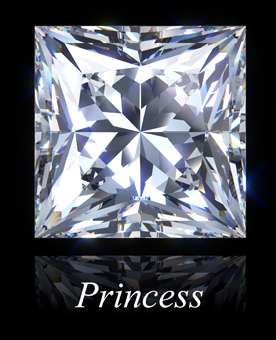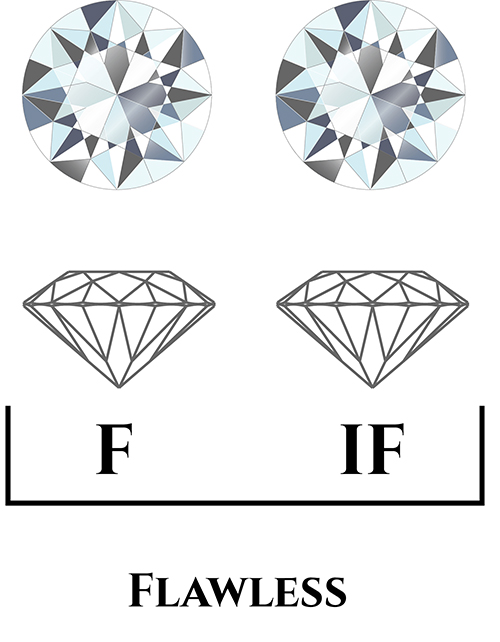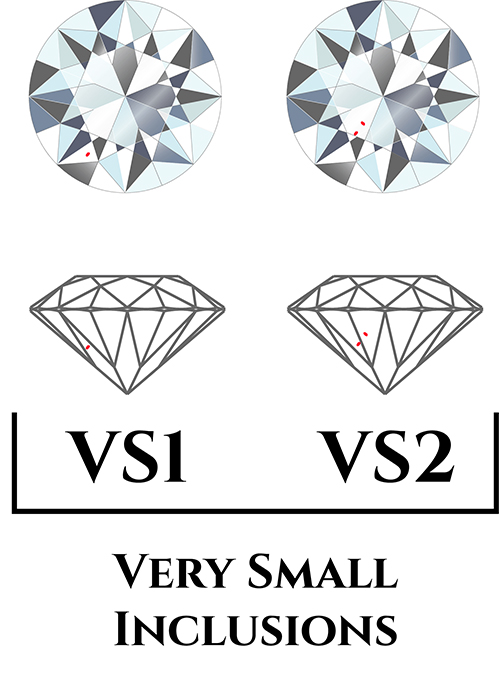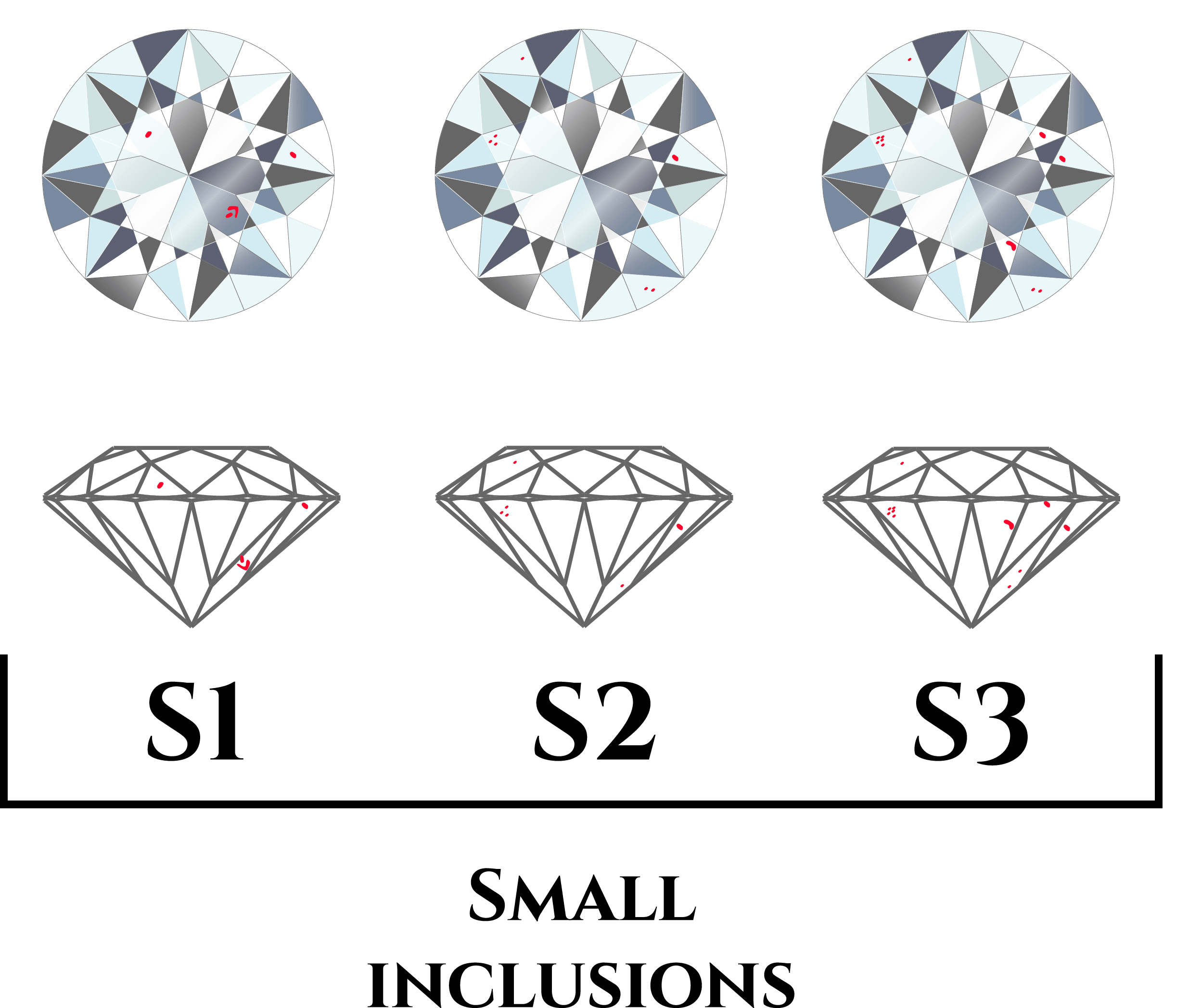- Anatomy
- 4'CS
- Fancy Colour
- Natural VS Man Made

Q1: Help me know a diamond better.
Buying loose diamonds or any diamond jewellery needs to be done carefully. You do not want to end up buying something that is of inferior quality. Hence, it is important to understand a diamond’s anatomy.
The ‘table’ is the gemstone’s largest facet. The top of a diamond that extends from its girdle to the table is called the ‘crown’. The ‘girdle’ that determines the diamond’s circumference is where the crown and the pavilion intersect. ‘Pavilion’ is the bottom of a diamond that extends from its girdle to ‘culet’, the facet at the gemstone’s tip. The ‘depth’ or the height of a gemstone is measured from its culet to table.

Q2: What are the four Cs I need to keep in mind when buying diamonds?
When you’re looking to buy loose diamonds, solitaire diamonds or any diamond jewellery, you must note the four Cs – the cut, colour, carat weight and clarity. These are crucial characteristics to ensure your purchase is authentic, pure and valuable.
When it comes to cut, clarity, colour and fluorescence, at Classy Cut, we offer a wide range between good to the very best. Classy Cut makes it easy for you to choose from the variety of diamonds we offer. On the grading scale, we place the diamonds rating them from good, better to the very best. Depending on your budget, you can choose from the D to N in colour, I1 to IF in clarity and D to N in colour (as per the internationally accepted diamond grading scales).
Q3: As a buyer, what grade diamonds make for the best value?
Only less than one per cent of diamonds are rated Flawless on the clarity scale, and hence, they tend to be astronomically expensive. At Classy Cut, we believe that diamonds rated VS and S1 make for the best purchase for buyers, in terms of value. The blemishes and inclusions on them aren’t visible to anyone but experts using magnification, making them more pocket-friendly and visually as superior as their Flawless counterparts. Classy Cut provides all customers with a certificate of authenticity for all diamond purchases.

- Carat
- Cut
- Colour
- Clarity

Q1: What is a diamond carat and why is it important?
Before you understand in detail what a diamond carat is, know with carat, it is the diamond’s weight that is being talked about and not size.
Here’s some trivia. Carat, as a term, finds its roots in ancient times when precious metals and stones were weighed against the carob tree seeds that were thought to be even in weight. At the Fourth General Conference on Weights and Measures, it was decided that one diamond carat would equal 200 mg or 0.2 grams of a diamond. One also measures carats in points - a carat equals 100 points.
When buying jewellery with Classy Cut or any other jeweller of your choice, remember to consider the cut of the diamonds when you compare their carat weights. If the cut is poor, a diamond with a higher carat weight may appear smaller than one that is well-cut but is of a lower carat.
While you might believe that it is the carat that impacts a diamond’s price the most, know that it is actually the cut that is the most crucial factor. So, when you buy jewellery or loose diamonds, keep in mind that a bigger diamond might not always be the better buy. The four Cs - cut, colour, clarity and carat - must be considered together when buying jewellery.
Q2: What are some important things I should know about diamond carat?
The following tips about carat will help you greatly when buying jewellery or loose diamonds:
-
Always focus on the cut more than the carat. It is what gives the diamond the sparkle. If the cut is poor, even a higher carat and quality will not help the diamond look anything but dull.
-
Looking to save money? The carat weight to go for is a little below the whole and half-carat marks. Choosing a 1.90 carat over a 2.00 carat can save you a decent sum.
-
Always keep the size in mind when buying a diamond wedding or engagement ring. Remember, the diamond will always look larger on small fingers.
-
Fancy-shaped diamonds tend to be less expensive than a round diamond of similar carat weight. Shapes can also make a diamond look larger than its actual carat weight size.
| Diamond Carate Weight | Round Diamond Carate Size Approximate |
| 0.25 ct. | 4.00 mm |
| 0.50 ct. | 5.10 mm |
| 0.75 ct. | 5.80 mm |
| 1.00 ct. | 6.40 mm |
| 1.25 ct. | 6.90 mm |
| 1.50 ct. | 7.30 mm |
| 1.75 ct. | 7.70 mm |
| 2.00 ct. | 8.10 mm |
| 2.25 ct. | 8.50 mm |
| 2.50 ct. | 8.90 mm |
| 2.75 ct. | 9.00 mm |
| 3.00 ct. | 9.30 mm |
| 3.25 ct. | 9.50 mm |
| 3.50 ct. | 9.75 mm |
| 3.75 ct. | 9.90 mm |
| 4.00 ct. | 10.10 mm |
| 4.25 ct. | 10.43 mm |
| 4.50 ct. | 10.63 mm |
| 4.75 ct. | 10.83 mm |
| 5.00 ct. | 11.01 mm |
Q1: What is a diamond’s cut? How does it matter?
It is simple! The cut of a diamond determines if its dimensions are proportioned properly. The cut allows the many surfaces (facets) of a diamond to sparkle. A proper cut significantly adds to the beauty and price of a diamond.
The best cut grade for you will depend on your budget.
At Classy Cut, you can always be assured of the finest quality and hence, we do not sell diamonds of low-cut grades. When buying jewellery with us, Classy Cut encourages you to choose diamonds of the best quality.
Do note that ‘diamond cut’ and ‘diamond shape’ refer to different things. A cut that is made up of factors like proportion, polish and symmetry. The shape, on the other hand, is about the diamond’s outline that could be round or non-round.
A well-cut diamond is characterised by brilliance (a reflection of white light), fire (the light’s dispersion into rainbow colours) and scintillation or the sparkle.
Q2: What are some of the most popular diamond cuts?
By far, the most popular diamond cut, the round diamond is characterised by its 58 facets. This cut has, for years, been the most popular choice for its brilliance and fire. Note that most brilliance in a round diamond are seen in the higher quality grades.

Round Brilliant Cut
By far, the most popular diamond cut, the round diamond is characterised by its 58 facets. This cut has, for years, been the most popular choice for its brilliance and fire. Note that most brilliance in a round diamond are seen in the higher quality grades.

Princess Cut
As elegant as its name, the princess cut gives the diamond the much attractive style and grace. This delicate cut comes in square and rectangular shapes with the former being more popular. The cut gives the diamond its exceptional brilliance and the colour emitted is dazzling too. It is noteworthy that the colour of other diamonds can be seen in the centre; in princess cut diamonds though, the unique colour is displayed in each corner of the diamond as well.

Emerald Cut
This unique rectangular step-cut gives a special optical appearance to the diamond. The emerald cut is a classic vintage one and offers an old-school charm that is loved by many. The cut highlights the diamond’s clarity with its large rectangular table.

Cushion Cut
Also popularly known as the ‘pillow cut’, the cushion cut diamond gets its name from its pillow-like shape. Characterised by its clarity and dazzling brilliance, which come from the round corners and large facets, cushion cut diamonds are offered in square and rectangular shapes. One of the cuts much in vogue, they make for the perfect choice for diamond wedding rings.

Radiant Cut
The trimmed corners of a radiant diamond are a coming together of the emerald cut and a round diamond’s brilliance. Combine some of the best-known diamond cuts and the sparkle of the radiant diamond will be mesmerising.

Marquise Cut
This cut that emphasises the diamond’s size is perfect to maximise carat weight. A unique shape gives a long and slender look to a wearer’s hand and fingers. Make sure you remember that when choosing a diamond engagement ring or a wedding ring.

Pear-shaped Cut
The teardrop-shape of the pear cut is a combination of the round and marquise cuts. Offering a soft and delicate look, this cut is also a popular choice for diamond wedding rings. The brilliance in this diamond cut is exceptional.

Asscher Cut
A modern take on the emerald cut, this cut is characterised by its sparkle and the square shape. Want a vintage look with a contemporary flair to your diamond? This cut should be your choice. Once a rage in the early 1900s, the asscher cut has regained popularity, particularly among celebs.

Oval Cut
Yet another contemporary twist to a classic look, the oval cut finds favour in any type of jewellery. A diamond engagement ring would look gorgeous with an oval cut diamond that makes the wearer’s finger look longer and slender. It offers a brilliance similar to round brilliant cut diamonds.

Heart-shaped Cut
True to its name, this one is an obvious choice among those romantic at heart. In a solitaire setting that further accentuates the shape of the heart cut diamond, it could be an ideal choice for a diamond wedding ring.

Q1: How important is the diamond colour?
One cannot emphasise enough how important a factor the diamond colour is when buying loose diamonds or diamond jewellery. The colour scale by the Gemological Institute of America (GIA) is the industry standard that begins at D and goes on till Z.
The colour of the diamond directly impacts its price. Lesser the hue, greater the value of a diamond. The purest and perfect diamond will have no hue and hence, will be more valuable. On the GIA colour scale, the D-F grade range is such colourless diamonds with an icy look that are of the highest quality and the rarest. Within the G-J grade range, one will find the near-colourless diamonds while the K grade with a faint hue is a budget pick.
Here’s a pro-tip. As the grade moves towards Z, the hue becomes faint, very light to light and thereby, the value and price decreases.
Q2: What diamond colour should I choose?
Eventually, it depends on your budget. As stated above, the colourless diamond, in the D to F grade range, is the rarest and most expensive. The near-colourless grade is also very popular depending on the budget and the choice of cut.
Q3: What are naturally-coloured diamonds?
It is not always that colourless diamonds are the most valuable. Naturally-coloured diamonds are even rarer. Only one in 10,000 diamonds have natural colour; a more intense natural colour, rarer and more valuable the diamond gets. When buying a coloured diamond, criteria like clarity and cuts become less important. They are popular simply for the exclusivity factor.
Q1: What does diamond clarity mean?
Assessing a diamond’s clarity means having a finer look at the defects on the surface of, and in the stone. These faults may or may not be visible to the naked eye; layman buyers will not be able to notice the difference in the diamonds they buy.
There are two types of flaws in diamonds: surface flaws or ‘blemishes’, and the imperfections under the surface known as ‘inclusions’. All of these put together give a diamond their natural character, measurable on the diamond clarity scale. Needless to say, the diamonds with the least blemishes and inclusions receive the highest grades, and will eventually cost buyers more.
Q2: What is the diamond clarity scale?
All over the world, diamonds are characterised on the basis of Clarity, Cut, Color and Carat, also known as the 4Cs. This scale helps exclude the diamonds that are deemed worthless and assigns an exact worth to the rest. The GIA created this revolutionary scale that now enables gemologists assess diamonds uniformly.
As per the scale, a significant number of mined diamonds are categorised under VS (very slightly included) or SI (Slightly Included) categories. An interesting thing to note here is that all diamonds are looked at under the extremely powerful 10x magnification. There are 11 grades as per the diamond clarity chart.
Below is a closer look at the scale:

Flawless (FL):
Extremely rare, and thereby priced the highest, a diamond with a Flawless rating has no visible inclusions or blemishes even under 10x magnification.
Internally Flawless (IF):
Diamonds assigned this grade typically have no inclusions. However, only experts can spot the blemishes under 10x magnification.

Very, Very Slightly Included (VVS1 and VVS2):
VVS1 and VVS2-rated diamonds contain inclusions that even expert assessors find hard to spot under 10x magnification.

Very Slightly Included (VS1 and VS2):
These diamonds come with minor inclusions that an expert can easily find under magnification.

Slightly Included (SI1 and SI3):
Diamonds declared SI have inclusions that are noticeable to an assessor using 10x magnification.

Included (I1, I2, and I3):
Rated lowest on the scale, I1, I2 and I3-rated diamonds have inclusions that are very apparent under 10x magnification. These diamonds are priced the lowest.

Q1: How to Grade fancy color diamonds?
Yellow or brown color diamonds having color more intense than "Z", as well as diamonds exhibiting color other than yellow or brown are considered fancy colored diamonds. These diamonds are graded using separate systems which indicate the characteristics of the color, and not just its presence. These color grading systems are more similar to those used for other colored gemstones, such as ruby, sapphire, or emerald, than they are to the system used for white diamonds
How to grade Colored diamond
Diamond colors more saturated than this scale are known as "fancy color" diamonds. Any light shade of diamond other than Light Yellow or Light Brown automatically falls out of the scale. For instance, a pale blue diamond won't get a "K", "N", or "S" color grade, it will get a Faint Blue, very Light Blue or Light Blue grade.
Laboratories use a list of 27 color hues that span the full spectrum for colored gems and diamonds (Red, Orangish-Red, Reddish-Orange, orange, Yellowish-Orange, Yellow-Orange, Orange-Yellow, Orangish-Yellow, Yellow, Greenish-Yellow, Green-Yellow, Yellow-Green, Yellowish-Green, Green, Bluish-Green, Blue-Green, Green-Blue, Greenish-Blue, Blue, Violetish-Blue, Bluish-Violet, Violet, Purple, Reddish-Purple, Red-Purple, Purple-Red, Purplish-Red). A modifying color combination can also be added (e.g., Olive or Brown-Olive) for stones without the purest hues. Additionally, for diamonds the following colors are used: White (which are milky), Black (which are opaque), Gray, Pink, Brown.
The saturation of these hues is then described with one of nine descriptors: Faint, Very Light, Light, Fancy Light, Fancy, Fancy Dark, Fancy Intense, Fancy Deep, Fancy Vivid.
The terms "Champagne", "Cognac" and "Coffee" refer to different types of brown diamonds. In the diamond processing/dealing industry, the word "Brown" is considered a killer as far as diamond value goes. Even though champagne is a light yellow color, champagne diamonds are Light Brown. Cognac is usually used to describe a diamond that is Orangish-Brown because cognac is a deep golden-orange color. Coffee is usually used to describe a diamond that is a Deep Brown or Vivid Brown color. Some grading agencies may also describe brown stones as Fancy Yellowish-Brown, Fancy Light Brown, Fancy Intense Brown, etc.

Q2: What is the Value of colored diamonds?
Diamonds that enter the Gemological Institute of America's scale are valued according to their clarity and color. For example, a "D" or "E" rated diamond (both grades are considered colorless) is much more valuable than an "R" or "Y" rated diamond (light yellow or brown). This is due to two effects: high-color diamonds are rarer, limiting supply; and the bright white appearance of high-color diamonds is more desired by consumers, increasing demand. Poor color is usually not enough to eliminate the use of diamond as a gemstone: if other gemological characteristics of a stone are good, a low-color diamond can remain more valuable as a gem diamond than an industrial-use diamond, and can see use in diamond jewellery. Furthermore, it is much more cost effective to purchase a near-colorless grade diamond (e.g. "G" rated) instead of a colorless grade diamond (e.g. "D" rated), as they are nearly indistinguishable to the naked untrained eye, especially when mounted on a ring setting.

When in the market shopping for diamonds, you will have the option to either choose a natural diamond that is cut and designed to best suit your needs or a lab-made diamond that possesses the same properties but is man-made.
Which one do you choose? It is a decision that is entirely yours. The joy of owning a diamond is unparalleled. Whether it is a natural diamond or a man-made one is a decision you take keeping in mind the purpose of your purchase, your personal preference and of course, your budget.
Let’s learn a little more about man-made diamonds.
Man-made diamonds or lab-grown diamonds or just synthetic diamonds have the same physical and chemical properties of a natural diamond. An untrained eye might not even note the difference. Instead of growing inside the earth, these are made in a laboratory.
They are produced being subjected to the same heat and pressure as a natural diamond in the earth’s crust. Make no mistake; synthetic diamonds are not fake but real diamonds.
Lab-grown diamonds are made in two ways - High Pressure-High Temperature or Chemical Vapour Deposition. Either way, the process involves similar conditions of heat and pressure that leads to mined diamonds.
When it comes to looks, synthetic diamonds are identical to its mined counterparts. Both could be colourless or almost colourless. Man-made diamonds, like natural diamonds, come in all the standard shapes like oval, round, pear, princess etc. The sparkle and brilliance are the same too.
When it comes to chemical composition, carbon remains the key element in man-made and mined diamonds. The only difference is the former contains small amounts of nitrogen while the latter do not. This is one way gemologists can make out a lab-grown diamond from a natural one. Other features that are signature of man-made diamonds include laser inscriptions and a unique fluorescence.
Quality-wise, lab-grown diamonds score over natural ones being Type IIa, the purest form. Most of the natural diamonds come with impurities and are categorised Type Ia.
Man made diamonds are becoming increasingly popular because while they look exactly like a mined diamond, they are environmentally-friendly. They are not mined unlike natural diamonds and hence, the impact on the environment is not adverse. Furthermore, they are created in laboratories and hence, are absolutely conflict-free. What also adds to the popularity of man-made diamonds is that they are priced up to 40% lower than natural diamonds.
At Classy Cut, you are offered the best of both variants. We give you a wide range of exquisite natural as well as man-made diamonds to choose from. Which one will you pick?






